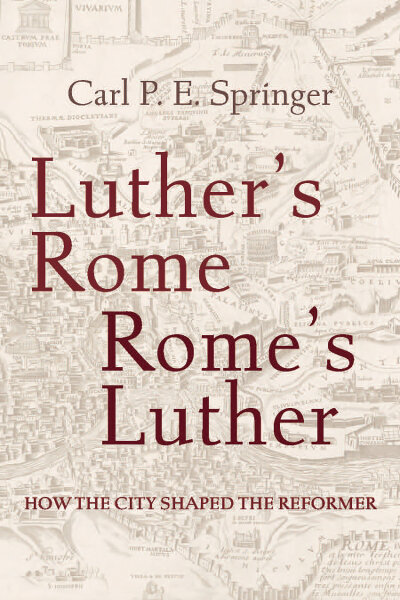Carl P. E. Springer

Reviewed by John G. Nordling on 08/26/2022
Sometime during his late twenties, Martin Luther traveled to Rome as a pilgrim from Germany and, after spending some four weeks there, returned home (1). Specific details as to what year the trip happened, which route he followed there and back, the identity of his traveling companion, just why he went, and exactly what he saw and did in the city have been lost to the mists of time—and to the vagaries of Luther’s memory, for the evidence, such as it is, was based on the reformer’s own recollections, usually presented decades after the fact. So one of the things Springer has done in this “masterpiece of Renaissance/Reformation scholarship” (dust jacket) is to sift through all those meaty Weimar volumes containing the reformer’s critical works, letters, biblical expositions, and table talks (written in Luther’s idiomatic German and Latin) with an eye toward gleaning details not only about the initial trip itself, but Luther’s complicated relationship toward Rome. Then there is all the secondary scholarship in English, German, French, and Italian devoted to these and related issues (see the bibliography, 259–277). Basically Springer supposes that Luther possessed a classic “love hate” relationship toward the eternal city and all that she represented to him and to the world. He was himself a son of the Roman Church, his “mother,” and the pope was his “father”—at least, at first. However, toward the end of his life there was a definite “hardening” as Luther realized that his earlier reforming efforts had come to naught: “His language directed against the Roman papacy became almost entirely condemnatory, and his humor turned more sardonic and bitter” (192). There was not nearly as much evidence of “love” as “hate” in his later writings toward those who set themselves in opposition to his prophetic proclamations.
The book is organized into four coordinated chapters that probe the complex relationship Luther possessed vis-à-vis Rome: (1) “Hail, Holy Rome!” (The Pilgrim); (2) “I Love Cicero” (The Latinist); (3) “The Kingdom Ours Remaineth” (The Citizen); (4) “If There Is a Hell, Rome Is Built on It” (The Catholic). The first chapter is longest, and the part wherein Springer attempts to retrace Luther’s original journey and weigh how much of it may have been true (see “Who Knows Whether It’s True?,” 49–60). Interestingly, support from the SunTrust Chair of Excellence in the Humanities, a post Springer currently holds at the University of Tennessee Chattanooga, made it possible for him in 2018–2019 to spend about six months trying to retrace Luther’s steps while on his way to and from Rome, and in the city itself (ix). In the second chapter, Springer exposes Luther’s formidable command of the Latin language and Roman history. In the third chapter, Springer points out Luther’s conservative political views, and that he was indeed a loyal citizen of the Holy Roman Empire—which, according to Voltaire, was never in any way “holy, nor Roman, nor an empire” (114). As such, Luther was inordinately respectful toward Charles V, even though the latter plainly did not “get” the Reformation, and even proved to be Luther’s implacable foe (126). In the fourth chapter, Springer sets forth Luther’s viscerally negative reactions toward the pope, shaped to some extent by the reformer’s declining health and even psychological factors (154–155). Despite Luther’s “negative speech” against Rome especially toward the end of his life, Springer attempts to demonstrate that the harsh language the reformer employed could be viewed as an acerbic preachment of the law—intended to drive the papists to repentance and forgiveness in the gospel (see “Law and Gospel,” 177–191): “The ultimate purpose of the scalpel is not to harm but to heal” (179).
Springer’s book demonstrates mastery not only of Latin philology and the ancient world in general, but also Luther’s spiritual struggles and finer points of Lutheran doctrine. As such, Springer himself is indubitably the leading voice in that movement known as Lutheranism and the Classics (there have been six conferences to date, hosted at Concordia Theological Seminary, Fort Wayne, in late September/early October on alternating years). Springer has written extensively on Martin Luther before—for example, Luther’s Aesop (2011) and Cicero in Heaven: The Roman Rhetor and Luther’s Reformation (2017). Springer’s latest book will be of interest to classicists, pastors, and laypersons who want to probe the reformer’s complicated relationship toward Rome, and Rome’s relationship toward him.



